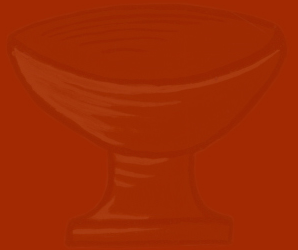
The Icon of the Crucifixion of Jesus Christ
This icon holds silence. Mouths are not open; nothing suggests sound. But St. Ignatius of Antioch said "He who possesses in truth the word of Jesus can hear even in silence".
The figures in this icon show emotion. Mary is often shown with her hand touching her face in grief and the other hand raised toward Christ, or one hand drawing her mantle closer and one hand raised toward Christ. John is shown, head down, sometimes touching his face in terror. Longinos, the Centurion has his face raised toward Christ witnessing his last words "Father, into thy hands I commit my spirit" (Luke 23:46).
At the bottom of the Cross is an open cave with a skull. Victory over death and hell is symbolized by a cavern, which opens at the foot of the cross, below the rocky summit of Golgotha, the rock that was rent, at the moment of Christ's death, to allow a skull to appear. It is the skull of Adam who, ' according to the belief of some", says St. John Chrysostom, would have been buried under Golgotha-the place of a skull" (John19: 17). If the tradition of iconography adopted this detail coming from apocryphal sources, it was because it served to bring out the dogmatic meaning of the icon of the Crucifixion: the redemption of the first Adam by the blood of Christ, the New Adam, Who made Himself man to save the human race."
The top bar of the cross held the accusation of the crucified person. The Byzantine icon has the insignia "King of Glory" which indeed is the true title of the crucified Christ. St. John Chrysostom says "I call Him King, because I see Him crucified. It belongs to the King to die for His subjects".
Christ's body in the icon is twisted right, his head bowed toward His mother, His eyes closed in death. "No one takes my life from me, but I lay it down of my own accord. I have power to lay it down, and I have power to take it up again" (John 10: 18).
There are eight ends to the cross. The number eight has an outside-of-time connotation. Sometimes the moon and the sun are placed above the cross. These symbols represent nature responding to the action of Christ and also the victory of light over darkness: " It was about the sixth hour and there was a darkness over all the earth until the ninth hour. And the sun was darkened, and the veil of the temple was torn in two" (Luke 23: 44-45).
Behind the Cross, the wall of Jerusalem is seen in many icons because Christ died outside the gates of Jerusalem at the same time that the Passover lamb is slaughtered outside the wall of Jerusalem.




